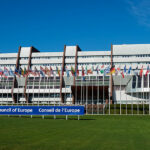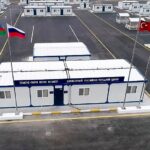BOTTOM LINE
- China, Turkey, and most of the countries in Central Asia and the Caucasus have long sought to create a Middle Corridor trade route that connects East Asia and Europe. Strategically, the trade route bypasses the Northern Corridor (which Russia dominates) and the traditional maritime route through the Indian Ocean (which the United States could interdict).
- The Middle Corridor’s key countries, notably Azerbaijan, China, Georgia, Kazakhstan, and Turkey, hope to capitalize on international interest in an alternative Eurasian trade route that avoids Russia.
- While trade along Middle Corridor has grown, several administrative, infrastructure, and political challenges must be overcome before it can seriously take on Eurasia’s other major trade routes.
The “Middle Corridor”—a loosely defined trade route that spans the Central Asian steppe, the Caspian Sea, and the Caucasus mountains—has both engendered excitement and disappointment for almost two decades. Also known as the China-Central Asia-West Asia Corridor, it links China and the markets of East Asia with Georgia, Turkey, and the markets of Europe. The corridor’s major components include the Trans-Caspian East-West-Middle Corridor Initiative, the Trans-Caspian International Transport Route, and the Trans-Caucasus Trade and Transit Corridor. For its advocates, the Middle Corridor will breathe new life into the ancient Silk Road.
Their excitement over the Middle Corridor lies in its potential to reduce the time needed to ship goods between East Asia and Europe to as few as twelve days. If achieved, it would give the Northern Corridor and seaborne trade via the Indian Ocean—Eurasia’s other two major trade routes—a run for their money. The Northern Corridor, which includes the New Eurasian Land Bridge and the Trans-Siberian Land Bridge through Russia, requires nineteen days to traverse. And the traditional maritime route through the Indian Ocean takes twenty-two to thirty-seven days. A full realization of the Middle Corridor’s potential could transform trade across Eurasia and, perhaps, the centers of power within it. But to fulfill that potential, the countries along the corridor will have to tackle several daunting administrative, infrastructure, and political challenges.
One Steppe at a Time
Disappointingly for its advocates, progress on the Middle Corridor, until recently, has been slow. Since Turkey first conceived of the corridor in the late 2000s, creating the necessary ferry, port, railway, and road infrastructure across Central Asia, the Caspian Sea, and the Caucasus has been a long and complex process. At first, countries along the trade route tried to patch together their existing transportation networks. But that was not enough to make the route competitive. The Middle Corridor’s first big step forward did not come until 2014, when the Trans-Kazakhstan railway opened. The next big step was the completion of the Baku-Tbilisi-Kars railway in 2017, enabling rail passage through the Caucasus mountains for the first time since the 1990s. Even so, it was not until 2020 when the first train using the Middle Corridor trade route arrived in China from Turkey.
Since that time, cargo shipments along the Middle Corridor have risen rapidly, albeit from a very low base. Goods moved along the corridor grew from roughly 350,000 tons to 530,000 tons between 2020 and 2021. But what really boosted the corridor’s use was Russia’s 2022 invasion of Ukraine and the West’s subsequent economic sanctions on Moscow. Though the countries of Central Asia have remained neutral in the conflict, they have seen an advantage in having an alternative to the Russian-dominated Northern Corridor, not to mention better infrastructure to support greater intraregional trade. As a result, cargo shipments along the Middle Corridor swelled to 3.2 million tons in 2022. Some now anticipate that the Middle Corridor’s capacity will climb to 10 million tons, given Turkey’s completion of the Marmaray railway under the Bosporus Strait, enabling rail cargo from Central Asia to travel directly into the heart of Europe. Indeed, European shipping companies have taken notice. Austria’s Rail Cargo Group, Denmark’s Maersk, Finland’s Nurminen Logistics, and the Netherlands’ Rail Bridge Cargo have all begun to use the Middle Corridor.
Seeking Alternatives in Central Asia and the Caucasus
Given the geopolitical uncertainty created by Russia’s 2014 invasion of Ukraine, it made sense for countries in Central Asia and the Caucasus to search for an alternative overland trade route to global markets independent of Russia. Azerbaijan, Georgia, and Kazakhstan, in particular, actively collaborated to turn the Middle Corridor into a reality. Together with China and Turkey, the five countries have held a series of conferences and ministerial meetings to improve their cross-border rail links and reduce trade friction between them.
Kazakhstan’s interest in the Middle Corridor has extended beyond trade to the geopolitical arena. Almaty likely sees its construction of a key segment of the Middle Corridor (as well as a part of the Northern Corridor) as important for not only its Bright Path (Nurly Zhol) domestic development strategy, but also for its grand strategy of better balancing its foreign relations with Beijing and Moscow. At the same time, the Middle Corridor promises to enhance its profile as a regional power center. With similar ambitions, other Central Asian countries, like Kyrgyzstan, Turkmenistan, and Uzbekistan, have emulated Kazakhstan’s approach and sought to build their own railways that would connect to the corridor.
China’s Efforts to Bypass Russia and the United States
China has been no less keen on the Middle Corridor. That is because Beijing has regarded all new trade routes across Eurasia as broadly beneficial. They give Chinese industry greater access to international markets and the Chinese government more clout in Central Asia, a region where Beijing and Moscow have long vied for influence. Indeed, that rivalry in large measure is what motivated Beijing’s enthusiasm for the Shanghai Cooperation Organization in the past. China appreciates that while it may currently share a “no limit” partnership with Russia, the longevity of that partnership is not guaranteed.
However, the extent to which China has influenced the Middle Corridor’s development is not so clear-cut. Pointing to the increasingly close ties between China and Kazakhstan and the praise that Azeri and Kazakh leaders regularly heap on China’s Silk Road Economic Belt Initiative, some have argued that Beijing may have shaped the infrastructure priorities of the corridor’s key countries. But while there is no doubt that those countries see China as crucial to making the Middle Corridor a success, few have taken out loans from China’s Belt and Road Initiative to build out their transportation networks. The reality of the situation might ultimately have as much to do with an alignment of Central Asian and Chinese goals as it does with China’s regional designs.
Whatever its intentions, China has invested in the logistics infrastructure that supports the Middle Corridor. It built the Khorgos Gateway and financed the Khorgos-Eastern Gates special economic zone, which together constitutes a vast rail transshipment center that straddles the Chinese-Kazakh border. Clearly, from Beijing’s perspective, having a trade route that Russia does not dominate (as in the case of the Northern Corridor) and the United States cannot directly interdict (as in the case of the traditional maritime route) is of strategic value to China.
Turkey Eyes Central Asia
At the European end of the Middle Corridor lies Turkey, a country whose interest in the corridor matches, if not exceeds, that of China. Ankara has seen the corridor as a way to not only build stronger economic ties to Central Asia, but also improve its strategic position. Turkey has hoped to do that by leveraging its common linguistic roots with Turkic-speaking countries in the region and offering them a trade outlet that is an attractive alternative to those of Iran or Russia, Turkey’s longtime rivals.
In fact, Turkey made the Middle Corridor the centerpiece of its foreign policy in Central Asia. Between 2013 and 2015, it inked agreements with Azerbaijan, China, Georgia, and Kazakhstan to improve the corridor’s connectivity to Europe. True to its word, Turkey built the Eurasia Tunnel and Yavuz Sultan Selim Bridge in Istanbul in 2016 and is completing the Edirne-Kars High-Speed Railway and the Northern Marmara Highway today. Diplomatically, Ankara even tried to bring Armenia and Azerbaijan together to facilitate the construction of a new Middle Corridor railway through Armenia’s Zanguzur region.
Slow-Motion Transformation
After Russia’s 2022 invasion of Ukraine, Middle Corridor advocates brimmed with excitement as geopolitical and economic interests put a global spotlight on the trade route. And, given that major components of the Middle Corridor are now complete, it appeared as though trade along the corridor was ready to boom. But several challenges still hold it back and must be addressed before cargo shipments can really surge: underdeveloped infrastructure and transfer services, the Caspian Sea’s summertime climate, border-crossing delays, and periodic political instability.
The first challenge concerns the Middle Corridor’s reliability. A trade route is only as good as its ability to move goods cheaply and on schedule. That requires efficient facilitation and intermodal transfer services, neither of which have been fully developed along the Middle Corridor yet. In contrast, Russia’s Trans-Siberian railway benefits from a network of services that was developed over many decades. Plus, the railway transits through large Russian and Belarussian industrial and population centers, which adds cargo volume and thereby defrays costs. While the Middle Corridor also hopes to foster more intraregional trade, the industrial and population centers in Central Asia and the Caucasus are far smaller than Russia’s.
Another challenge is the climate around the Caspian Sea, a body of water over which much of the Middle Corridor’s trade must pass. The Caspian Sea’s notoriously rough waters during the summer can delay ferries for weeks at a time, exacerbating the often-bad congestion at the port of Baku. While Azerbaijan has sought to expand Baku’s port capacity with new terminals and ferries, it can do little about the weather. That is likely one reason why Rail Bridge Cargo still estimates its cargo transit time through the corridor to be thirty-six to forty days.
Still another challenge for the Middle Corridor is red tape. Since the Middle Corridor passes through multiple countries, border delays due to customs and tariff collection are common. To be sure, the problem is well known. For years, representatives from Azerbaijan, Georgia, Kazakhstan, and Turkey have met to sort them out. But it was not until November 2022 that they crafted a roadmap to do so. Unfortunately for them, the roadmap is expected to take at least five years to fully implement.
A final issue deals with the prospect of civil and international conflict along the Middle Corridor that could, at the very least, raise insurance premiums for trade. The issue is not an academic one. In January 2022, Kazakhstan experienced three weeks of unrest that required the intervention of Russian troops to quell. Kyrgyzstan experienced similar periods of unrest in 2010 and 2020. And, in September 2022, armed clashes between Azerbaijan and Armenia resulted in over 800 casualties and led the former to block access to the disputed Nagorno-Karabakh enclave three months later, hardly a solid basis for cross-border commerce.
Certainly, trade along the Middle Corridor has grown, despite concern over weak demand that existed as recently as 2021. But that growth should be kept in perspective. Even as the countries along the Middle Corridor strive to triple their capacity to 10 million tons of cargo, Russia’s Trans-Siberian railway alone moved 144 million tons of cargo in 2020 and the traditional maritime route will convey well over one billion tons in 2023. And, should global demand slacken, budding trade routes like the Middle Corridor could get pinched. Russia’s invasion of Ukraine may have set the Middle Corridor on the right track, but its destination may still be some distance away.
Felix K. Chang is a senior fellow at the Foreign Policy Research Institute. He is also the Chief Operating Officer of DecisionQ, a predictive analytics company, and an assistant professor at the Uniformed Services University of the Health Sciences.











